After thousands of ocean miles,
a Nor’Sea 27 finds more waters to explore via highway.
Issue 145: July/Aug 2022
The burgundy-colored jug, bearing the logo of a winery somewhere on France’s Canal du Midi, had been sitting next to our woodstove for seven years. Filled now with Bahamian sand, the jug and its contents served as a memory of what had been a solemn promise that my wife, Ellen, and I had made to return, someday, to France or the Bahamas—it made no difference, as long as it was by sea.
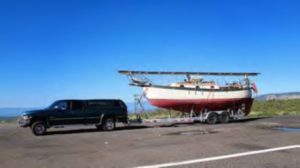
The “asphalt yacht” with Entr’acte rigged for land travel.
It had been another long day of work on Entr’acte, our Nor’Sea 27 huddled on her trailer under cover beside our house outside New York City. The sound of snow falling heavily on the shelter seemed totally out of place with the Bahamian music on our tape player. Tired and cold, we returned inside to regroup. As we sat and gazed at the fire, our eyes fell to that wine jug full of sand and the idea suddenly hit us: “The boat and trailer are ready to go. With the proper tow vehicle, we can be back in the Bahamas in no time.”
So began a new chapter in the story of our relationship with this remarkable “small” boat, a story that opened when we were young newlyweds with bluewater dreams. We had searched the East Coast for a suitable vessel without success until we saw the ad for the Nor’Sea 27. Designed by Lyle Hess, it embodied everything we desired in an ocean-going vessel and seemed like an affordable option because we could buy a bare hull and deck and complete it ourselves. It was love at first sight.
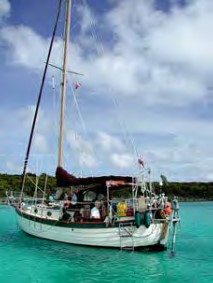
Back in the Bahamas, Entr’acte and crew take a break from the workaday and return to the cruising life.
That the boat was advertised as a seaworthy trailer-sailer seemed a stretch—and why would we want a trailer anyway? We dreamed about crossing oceans, not interstates. But as it turned out, purchasing a trailer with the boat was the smartest choice we could have made. Not only did it enable us to work on the boat where we wanted, when we wanted, it has given us the flexibility to continue to develop our careers while also letting us quickly return to places that we love, as well as discover destinations we had not before considered.
It took us awhile—about 30,000 bluewater miles, and that jug full of sand holding us to our promise—but we have grown to fully appreciate bluewater trailer-sailing, and the Nor’Sea 27 has proven over and over Shakespeare’s observation: “Though she be but little, she is fierce.”
Bluewater Sailors
Truth is, the trailer almost sunk the whole deal, at first. We loved the design, and while we could afford an unfinished hull and deck, the trailer and other associated costs—including shipping her from California to our home—quickly drove her out of range budget-wise. We were heartbroken.
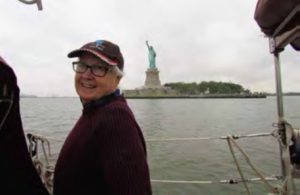
Trips past the Statue of Liberty became regular as the Zackos cruised the Hudson River and then Long Island Sound.
Then a company representative called and told us that they had a trailer coming east with a new boat that would tour the New England boat shows by land. They planned to launch the boat after the show in Stamford, Connecticut, and demonstrate its passage-making ability by sailing to the Annapolis show. They offered us the used trailer at a reduced price.
This changed everything. Not only did we save half the shipping charges, now we could build our dream at home. By October 18, 1976, hull #44, which was to become Entr’acte, sat regally beneath a pine tree in our backyard. A mere two months into our project, we realized that had we tried to do this in a boatyard, our work schedule, coupled with the complication, inconvenience, and costs of boatyard storage and commuting to work on the boat, would have eventually worn us down and buried us.
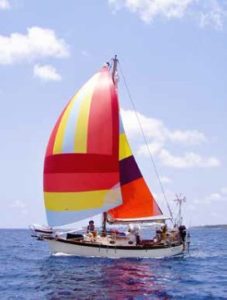
Entr’acte shows off her Nor’Sea 27 bluewater chops
We launched Entr’acte in the spring of 1980, during the last snowstorm of the season. A year later, after a long winter of final, frantic preparations, we were ready. Young, fearless, and reasonably well-capitalized for what was supposed to be a one-year voyage, we departed New York. After a summer warm-up in New England, we made for the Chesapeake Bay, then the Bahamas, Caribbean, Bermuda, the Azores, two years in Europe, the French Canals, then back across the Atlantic to see every island from Martinique to Florida.
We returned to the Chesapeake Bay in October 1986, and after 13,000 miles, Entr’acte was reunited with her trailer. It was time to get serious about working again, and we could not afford any distraction. It seemed prudent to leave her with friends on the Chesapeake’s Eastern Shore, where she might be out of sight, out of mind, but she would stay secure in a field, quietly awaiting our return. And, we wouldn’t have to sell her, as did so many of our cruising friends when they returned to land.
Three years later we were financially and professionally in a position to hire a friend with a Suburban to bring Entr’acte home. After cleaning her up and making a few improvements, we moored her in a marina on the Hudson River just 10 miles from home, where we could unwind for a few hours here and there and sometimes grab several days in a row.
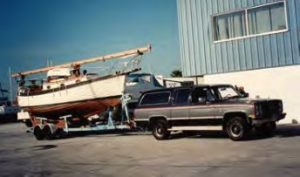
The first tow vehicle was a 1986 Suburban, barely adequate to haul Entr’acte long distance. The Zackos learned that plenty of torque and a large cooling system are more important than horsepower.
The Hudson, while beautiful, quickly became confining, and next season found us back on Long Island Sound. It was wonderful to return to real, open-water sailing, and for a while, this became an annual ritual. But it simply wasn’t enough.
We longed for the adventure and independence that comes with crossing oceans, but we were also hitting our stride professionally and needed to take care. We remained stuck in this limbo until that snowy day, when the wine jug full of sand prompted the revelation: If we had our own tow vehicle, we could go anytime.
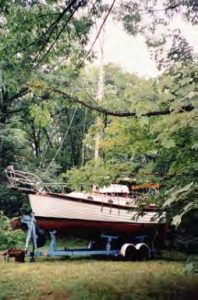
Entr’acte fully rigged on the original trailer in Ed and Ellen’s yard. They also made a simple rig that let them raise and lower the mast while on the trailer.
Road Warriors
The plan was simple: one week to Florida, one week to commission, three weeks in the Bahamas and a week to get home. We could safely arrange that much time away from work. It would have to do.
After weeks of serious searching, we found an ’86 Suburban that we felt could pull our 10,000-pound boat—after replacing a suddenly locked-up rear differential.
Our first road trip to Florida was an adventure itself. With barely enough power to maintain highway speed, the big, burdened V-8 guzzled gas at 8 mpg, and its engine temperature gauge hovered far too close to the danger zone for comfort.
Still, we made landfall at Indian Harbor Marina on day five of our overland passage. Despite our relatively slow average highway speed over ground of 50 mph, it was 10 times faster and 100 times more comfortable than sailing that same distance to windward.
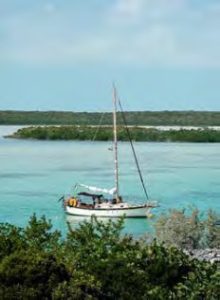
Solitude at anchor was one of the greatest benefits of trailer-sailing to the Bahamas in the summer. More open weather windows also meant that the Zackos could drive to Florida from New York City, launch the boat, and be across the Gulf Stream and checking in to the Bahamas in as little as three days.
The moment Entr’acte splashed, we immediately transformed from “house people” to ocean sailors once again. Two days later, truck and trailer in storage, the last of the provisions stowed, it was as if we had never moved ashore.
The rest was easy. We knew where we were, where we were going, and most importantly, how to get there. One day on the Intracoastal Waterway found us at West Palm Beach inlet waiting for our next weather window to cross the Gulf Stream. It arrived a few days later, and we left for Grand Bahama Island, 60 miles east. We took up a heading of 135 degrees magnetic to compensate for the northward flow of the Gulf Stream and immediately settled into our old routine.
We motor-sailed into a light southeasterly breeze under a nearly full moon, and our landfall just after sunrise the next morning was as magical as our first one had been 10 years earlier. Our anchor went down, and that beautiful, clear, turquoise water danced in our eyes to the rhythm of Bahamian Goombay coming from our FM radio. We were home again!
Expanding Horizons
Over the next several weeks we enjoyed fabulous reunions with old friends. Somehow, what was supposed to have been three weeks stretched well beyond into August, where we found ourselves down in the Exuma Cays—a long way from home with a due date for being back at work in September and hurricane season upon us.
It took more than a month to meander from Grand Bahama all the way to Georgetown, Exuma, but in one day with a 15-knot trade wind astern, we rocketed to the top of the Exuma chain. The second night found us anchored in Nassau, where learned that Hurricane Andrew was coming.
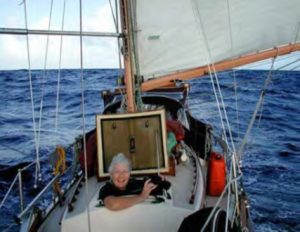
Ellen pops up from the hatch during a rollicking downwind passage back to Florida from the Bahamas.
The story of our encounter with Andrew must be saved for another time. We survived it, but we were later than ever. Now we really had to make tracks. Under full sail with the trade winds and Gulf Stream astern, we flew back to Florida at a speed over ground of over 14 knots. We stopped just long enough to clear customs, and as Entr’acte redlined it, we placed a call to the marina.
When we arrived, the lift was set and running, straps in the water waiting. We flew into the slipway at full throttle making a full-astern crash stop. Twenty minutes later, Entr’acte was on her now-beloved trailer, and three hours later, Indian Harbor Marina was, sadly, far astern. Three days later, Entr’acte sat next to our house, the truck empty, the storage shed full. We were home a scant six hours before we had to return to work.
Our experiment had been eminently successful. In addition to the supreme enjoyment of returning to our life at sea, we had learned a few things. First, Entr’acte was, as advertised, an oceangoing vessel that was seriously trailerable. Second, trailering wasn’t that bad! (We quickly purchased a Dodge Ram pickup with a diesel engine that could easily tow 10 Nor’Seas.)
The greatest success of this voyage was the certainty we could survive a few more years of working before we took off on another long cruise. Now, when work seemed unbearable, our safety valve was knowing that in only a few days we could be back in the Bahamas or anywhere else we wanted.
The winter work schedule of ’94 was so wild and tense that by spring we were truly motivated. The moment our obligations were satisfied, we exploded out
of New York on a Friday, and on Monday afternoon, an astonishing three days later, set the anchor at West End, Grand Bahama Island. The almost total silence of our anchorage was in stunning contrast to the chaos of the preceding winter and spring. Completely alone, speaking in barely a whisper, we simply sat there for an entire week, decompressing.
Weeks later, instead of going directly home, we decided to carry on and relaunch on Long Island Sound to enjoy the fall sailing through September and October as our work schedule permitted.
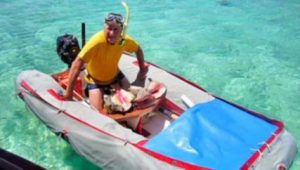
Collecting conch for dinner is just one of the pleasures of making the transition back to the cruising life.
Well and truly hooked on this trailer thing, we settled into an annual routine of working all winter to the max with the goal of summer in the Bahamas followed by fall in New England as our reward. This served beautifully until 2002, when we finally set off once again to see the world.
Now firmly based in Arizona, Entr’acte and her crew are not as far from the sea as one would imagine. After her refit in a community indoor workspace, (see “Testing Their Metal,” May/June 2021, and “An Encore for Entr’acte, September/October 2021) she finally explored San Francisco Bay and the following year saw a reprise of the Bahamas-to-New England route.
This past season, Entr’acte once again took to the road for a herculean, 4,000-mile, land-and-sea passage. After driving from Arizona to launch in upstate New York, we cruised down the Hudson River into Long Island Sound, sailing Down East to Maine, then finally hitting the road back to Arizona.
Where to next? Who knows—from here, the Sea of Cortez is a mere five hours away. Twist my arm!
Good Old Boat Contributing Editor Ed Zacko, a drummer, and his wife, Ellen, a violinist, met in the orchestra pit of a Broadway musical. They built their Nor’Sea 27, Entr’acte, from a bare hull, and since 1980 have made four transatlantic and one transpacific crossing. After spending a couple of summers in southern Spain, Ed and Ellen shipped themselves and Entr’acte to Phoenix, where they have refitted Entr’acte while keeping up a busy concert schedule in the Southwest U.S. They recently completed their latest project, a children’s book, The Adventures of Mike the Moose: The Boys Find the World.
Thank you to Sailrite Enterprises, Inc., for providing free access to back issues of Good Old Boat through intellectual property rights. Sailrite.com





